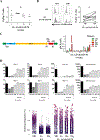Intrathymic adeno-associated virus gene transfer rapidly restores thymic function and long-term persistence of gene-corrected T cells
- PMID: 31513879
- PMCID: PMC8287836
- DOI: 10.1016/j.jaci.2019.08.029
Intrathymic adeno-associated virus gene transfer rapidly restores thymic function and long-term persistence of gene-corrected T cells
Abstract
Background: Patients with T-cell immunodeficiencies are generally treated with allogeneic hematopoietic stem cell transplantation, but alternatives are needed for patients without matched donors. An innovative intrathymic gene therapy approach that directly targets the thymus might improve outcomes.
Objective: We sought to determine the efficacy of intrathymic adeno-associated virus (AAV) serotypes to transduce thymocyte subsets and correct the T-cell immunodeficiency in a zeta-associated protein of 70 kDa (ZAP-70)-deficient murine model.
Methods: AAV serotypes were injected intrathymically into wild-type mice, and gene transfer efficiency was monitored. ZAP-70-/- mice were intrathymically injected with an AAV8 vector harboring the ZAP70 gene. Thymus structure, immunophenotyping, T-cell receptor clonotypes, T-cell function, immune responses to transgenes and autoantibodies, vector copy number, and integration were evaluated.
Results: AAV8, AAV9, and AAV10 serotypes all transduced thymocyte subsets after in situ gene transfer, with transduction of up to 5% of cells. Intrathymic injection of an AAV8-ZAP-70 vector into ZAP-70-/- mice resulted in a rapid thymocyte differentiation associated with the development of a thymic medulla. Strikingly, medullary thymic epithelial cells expressing the autoimmune regulator were detected within 10 days of gene transfer, correlating with the presence of functional effector and regulatory T-cell subsets with diverse T-cell receptor clonotypes in the periphery. Although thymocyte reconstitution was transient, gene-corrected peripheral T cells harboring approximately 1 AAV genome per cell persisted for more than 40 weeks, and AAV vector integration was detected.
Conclusions: Intrathymic AAV-transduced progenitors promote a rapid restoration of the thymic architecture, with a single wave of thymopoiesis generating long-term peripheral T-cell function.
Keywords: Severe combined immunodeficiency; T-cell reconstitution; gene therapy; humoral immunity; intrathymic gene transfer; medulla formation; thymus; zeta-associated protein of 70kDa.
Copyright © 2019 American Academy of Allergy, Asthma & Immunology. All rights reserved.
Figures







Comment in
-
Intrathymic delivery a new route for adenoviral-associated vector gene therapy.J Allergy Clin Immunol. 2020 Feb;145(2):499-501. doi: 10.1016/j.jaci.2019.11.037. Epub 2019 Dec 9. J Allergy Clin Immunol. 2020. PMID: 31830489 No abstract available.
Similar articles
-
In vivo correction of ZAP-70 immunodeficiency by intrathymic gene transfer.J Clin Invest. 2005 Aug;115(8):2287-95. doi: 10.1172/JCI23966. J Clin Invest. 2005. PMID: 16075064 Free PMC article.
-
Correction of T cell deficiency in ZAP-70 knock-out mice by simple intraperitoneal adoptive transfer of thymocytes.Clin Exp Immunol. 2018 Jun;192(3):302-314. doi: 10.1111/cei.13114. Epub 2018 Mar 12. Clin Exp Immunol. 2018. PMID: 29431868 Free PMC article.
-
Efficient intrathymic gene transfer following in situ administration of a rAAV serotype 8 vector in mice and nonhuman primates.Mol Ther. 2009 Mar;17(3):472-9. doi: 10.1038/mt.2008.272. Epub 2008 Dec 16. Mol Ther. 2009. PMID: 19088703 Free PMC article.
-
Adeno-Associated Virus Vectors and Stem Cells: Friends or Foes?Hum Gene Ther. 2017 Jun;28(6):450-463. doi: 10.1089/hum.2017.038. Hum Gene Ther. 2017. PMID: 28490211 Free PMC article. Review.
-
Adeno-associated viral vectors for correction of inborn errors of metabolism: progressing towards clinical application.Curr Pharm Des. 2011;17(24):2500-15. doi: 10.2174/138161211797247569. Curr Pharm Des. 2011. PMID: 21774772 Review.
Cited by
-
AAV integration in human hepatocytes.Mol Ther. 2021 Oct 6;29(10):2898-2909. doi: 10.1016/j.ymthe.2021.08.031. Epub 2021 Aug 28. Mol Ther. 2021. PMID: 34461297 Free PMC article.
-
Lymphotoxin: from the physiology to the regeneration of the thymic function.Cell Death Differ. 2021 Aug;28(8):2305-2314. doi: 10.1038/s41418-021-00834-8. Epub 2021 Jul 22. Cell Death Differ. 2021. PMID: 34290396 Free PMC article. Review.
-
Delivering CRISPR to the HIV-1 reservoirs.Front Microbiol. 2024 May 15;15:1393974. doi: 10.3389/fmicb.2024.1393974. eCollection 2024. Front Microbiol. 2024. PMID: 38812680 Free PMC article. Review.
-
Intrathymic AAV delivery results in therapeutic site-specific integration at TCR loci in mice.Blood. 2023 May 11;141(19):2316-2329. doi: 10.1182/blood.2022017378. Blood. 2023. PMID: 36790505 Free PMC article.
-
T-cell specific in vivo gene delivery with DART-AAVs targeted to CD8.Mol Ther. 2024 Oct 2;32(10):3470-3484. doi: 10.1016/j.ymthe.2024.08.002. Epub 2024 Aug 8. Mol Ther. 2024. PMID: 39113357 Free PMC article.
References
-
- Heimall J, Puck J, Buckley R, Fleisher TA, Gennery AR, Neven B, et al. Current Knowledge and Priorities for Future Research in Late Effects after Hematopoietic Stem Cell Transplantation (HCT) for Severe Combined Immunodeficiency Patients: A Consensus Statement from the Second Pediatric Blood and Marrow Transplant Consortium International Conference on Late Effects after Pediatric HCT. Biol Blood Marrow Transplant. 2017; 23(3):379–387. - PMC - PubMed
-
- Fischer A, Hacein-Bey-Abina S, Cavazzana-Calvo M. Gene therapy for primary immunodeficiencies. Hematology/oncology clinics of North America. 2011;25(1):89–100. - PubMed
-
- Aiuti A, Cattaneo F, Galimberti S, Benninghoff U, Cassani B, Callegaro L, et al. Gene therapy for immunodeficiency due to adenosine deaminase deficiency. N Engl J Med. 2009;360(5):447–58. - PubMed
Publication types
MeSH terms
Substances
Grants and funding
LinkOut - more resources
Full Text Sources
Other Literature Sources
Medical
Research Materials

